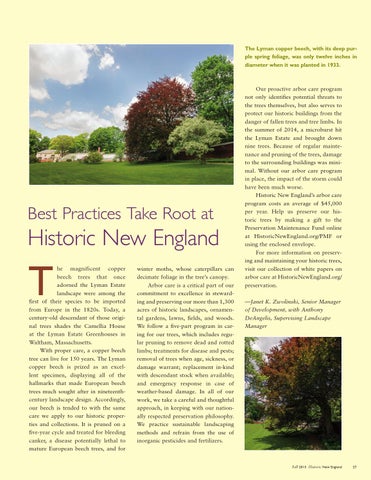The Lyman copper beech, with its deep purple spring foliage, was only twelve inches in diameter when it was planted in 1933.
Best Practices Take Root at
Historic New England
T
he magnificent copper beech trees that once adorned the Lyman Estate landscape were among the first of their species to be imported from Europe in the 1820s. Today, a century-old descendant of those original trees shades the Camellia House at the Lyman Estate Greenhouses in Waltham, Massachusetts. With proper care, a copper beech tree can live for 150 years. The Lyman copper beech is prized as an excellent specimen, displaying all of the hallmarks that made European beech trees much sought after in nineteenthcentury landscape design. Accordingly, our beech is tended to with the same care we apply to our historic properties and collections. It is pruned on a five-year cycle and treated for bleeding canker, a disease potentially lethal to mature European beech trees, and for
winter moths, whose caterpillars can decimate foliage in the tree’s canopy. Arbor care is a critical part of our commitment to excellence in stewarding and preserving our more than 1,300 acres of historic landscapes, ornamental gardens, lawns, fields, and woods. We follow a five-part program in caring for our trees, which includes regular pruning to remove dead and rotted limbs; treatments for disease and pests; removal of trees when age, sickness, or damage warrant; replacement in-kind with descendant stock when available; and emergency response in case of weather-based damage. In all of our work, we take a careful and thoughtful approach, in keeping with our nationally respected preservation philosophy. We practice sustainable landscaping methods and refrain from the use of inorganic pesticides and fertilizers.
Our proactive arbor care program not only identifies potential threats to the trees themselves, but also serves to protect our historic buildings from the danger of fallen trees and tree limbs. In the summer of 2014, a microburst hit the Lyman Estate and brought down nine trees. Because of regular maintenance and pruning of the trees, damage to the surrounding buildings was minimal. Without our arbor care program in place, the impact of the storm could have been much worse. Historic New England’s arbor care program costs an average of $45,000 per year. Help us preserve our historic trees by making a gift to the Preservation Maintenance Fund online at HistoricNewEngland.org/PMF or using the enclosed envelope. For more information on preserving and maintaining your historic trees, visit our collection of white papers on arbor care at HistoricNewEngland.org/ preservation. —Janet K. Zwolinski, Senior Manager of Development, with Anthony DeAngelis, Supervising Landscape Manager
Fall 2015 Historic New England
27
